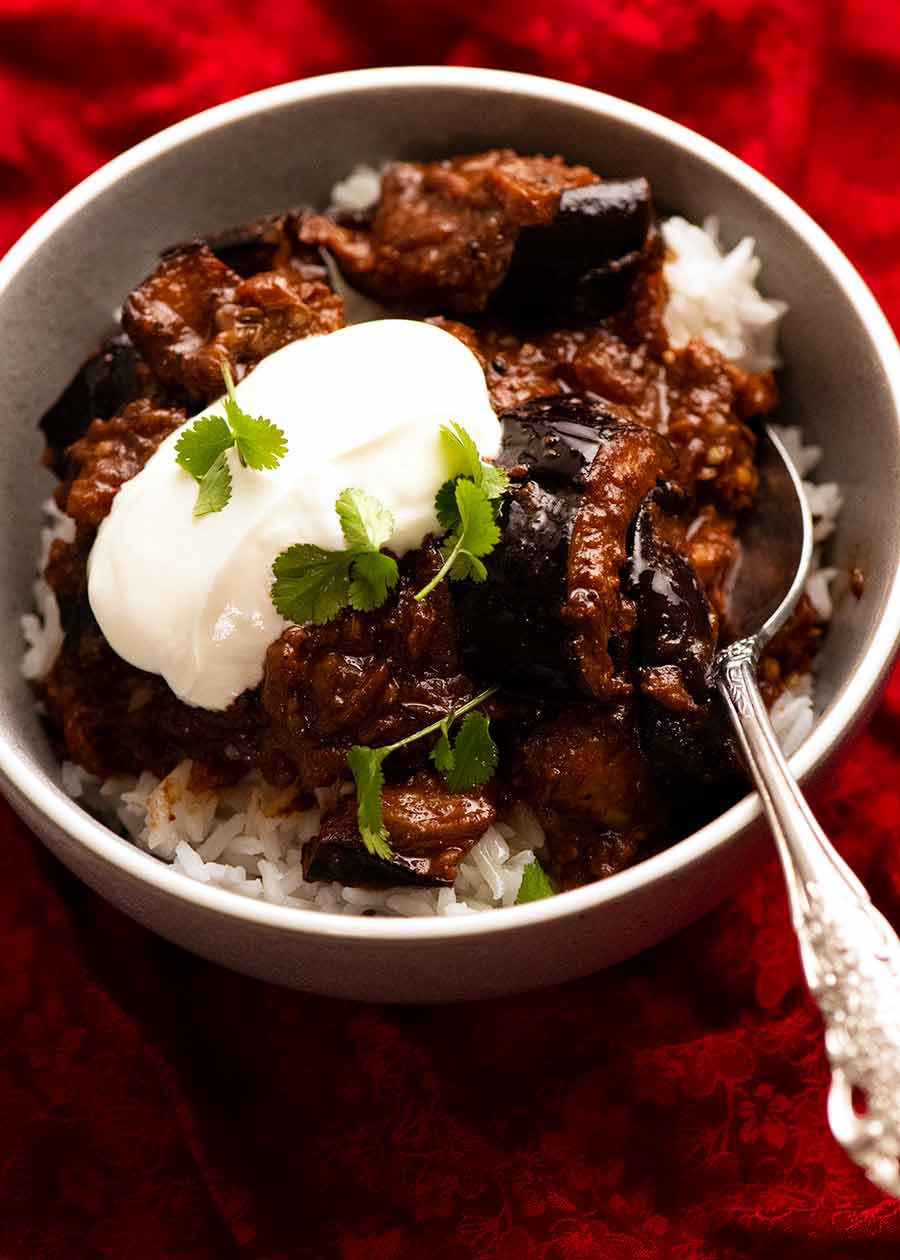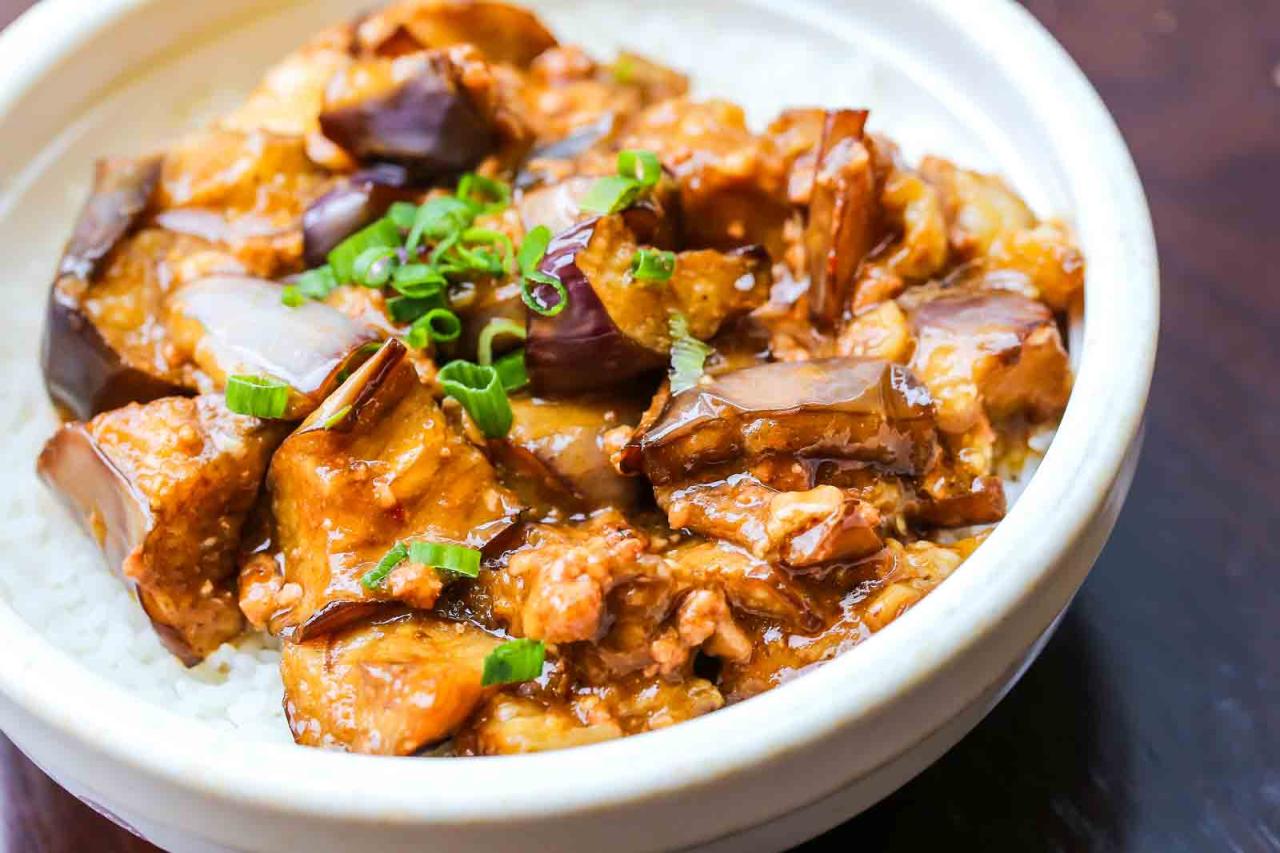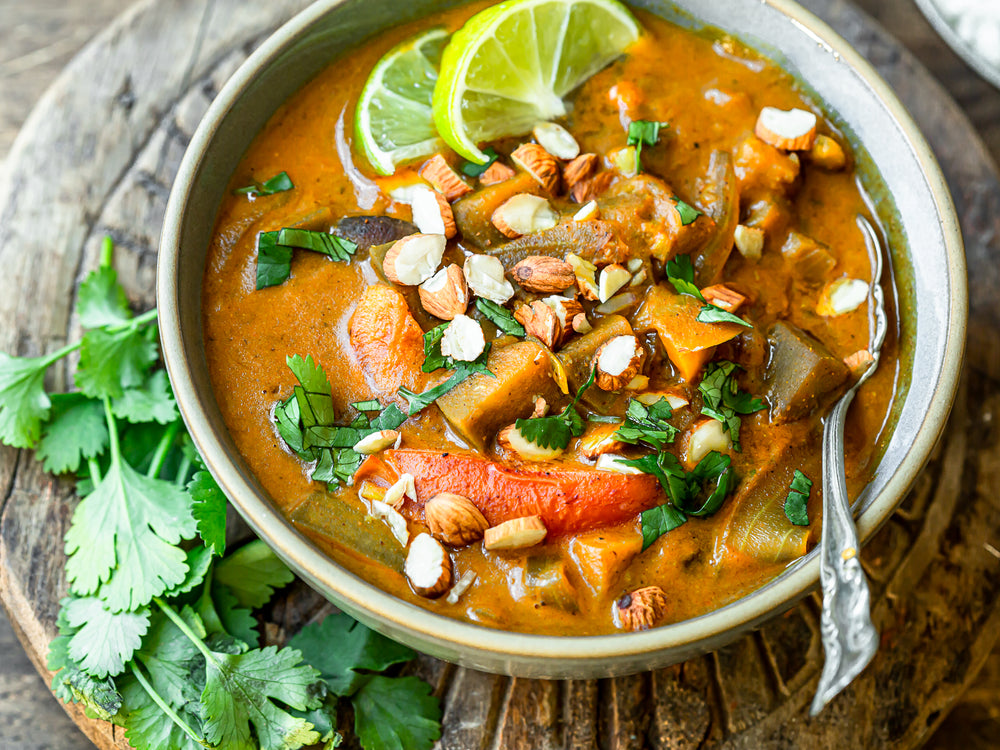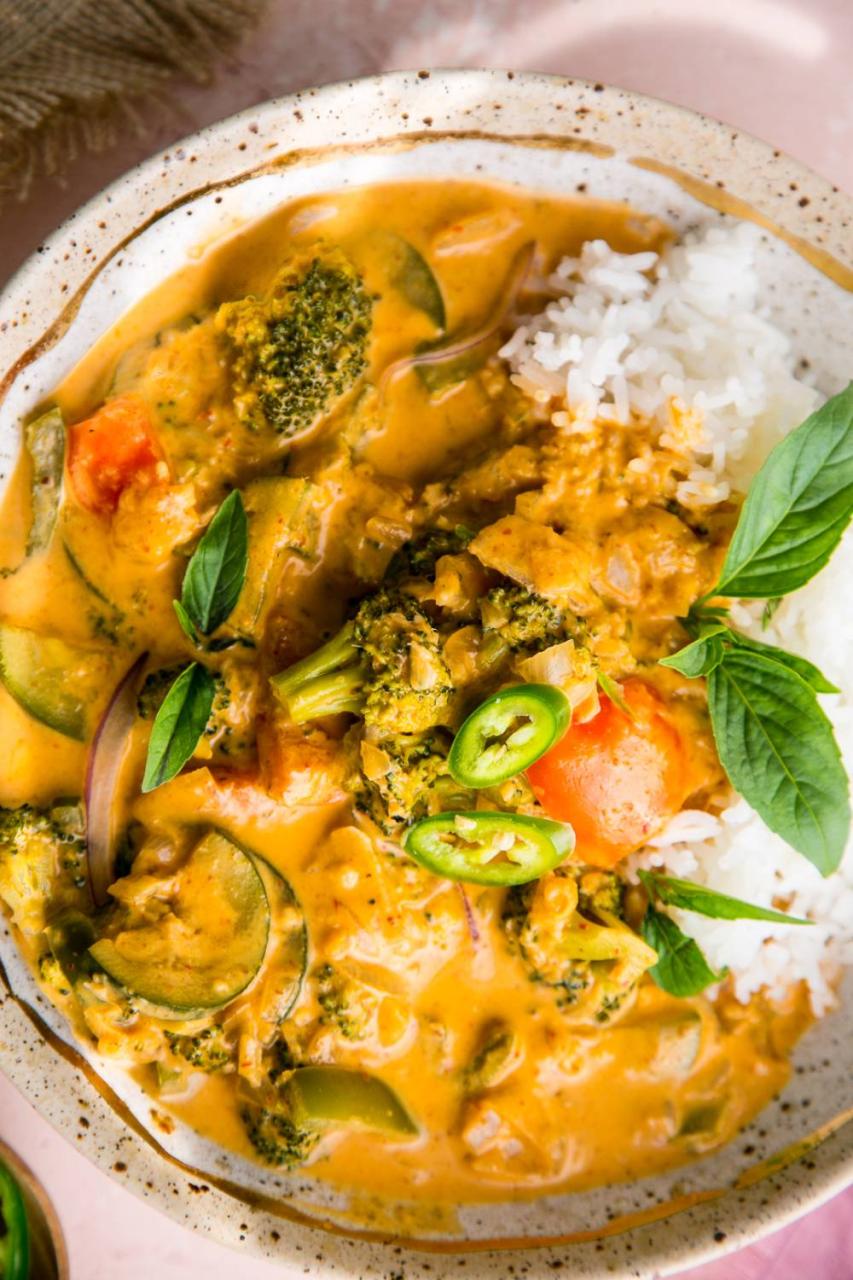An Eggplant Curry, also known as Aubergine Curry, is an indulgent yet nutritious dish that hinges on the rich flavors and velvety texture of eggplants. This culinary delight finds its roots in various cuisines across the globe, particularly in South Asian and Mediterranean regions where eggplants are a staple ingredient. The curry can vary significantly in taste and preparation methods, reflecting the diverse culinary landscapes it comes from, including Indian, Thai, and Middle Eastern versions, among others.
Eggplant, with its sponge-like texture, absorbs flavors beautifully, making it perfect for soaking up the aromatic spices and herbs typically used in curries. Ingredients like turmeric, cumin, coriander, ginger, and garlic are commonly paired with eggplants to enhance the dish’s flavor profile. Depending on the regional recipe, coconut milk, tomatoes, or yoghurt might be added to achieve a creamy, rich base that complements the tender, earthy slices of eggplant.
Nutritionally, eggplants are a fantastic source of dietary fiber, vitamins, and minerals, contributing to improved digestion, heart health, and overall well-being. When melded into a curry with a plethora of spices and possibly other vegetables, this dish becomes a heartwarming, potent source of both nutrients and antioxidants.
Eggplant Curry Recipe


Eggplant Curry
Equipment
- 1 pressure cooker
Ingredients
- 1/4 tsp. Pepper
- 1/2 c. Vegetable stock
- 1 tsp. Salt
- 2 Tbsp. Olive oil
- 2 Tbsp. Chopped cilantro
- 1/2 tsp. Chili powder
- 1 Cubed eggplant
- 1/2 tsp. Cumin seeds
- 1/2 tsp. Turmeric
- 1 Sliced green chili
- 1 Chopped onion
- 1/2 c. Diced tomatoes
- 1 Cubed potato
Instructions
- For this recipe to begin, prepare the pressure cooker by adding in some oil and the cumin seeds and letting these cook together until you hear them crackle.
- Once the crackling begins, add in the onion and green chili and let them heat up and become tender.
- Now the eggplant, potato, tomato, cilantro, pepper, salt, turmeric, and chili powder should be added into the pressure cooker one at a time and stirred around.
- Before placing and sealing the lid onto the pressure cooker, add in your vegetable stock and mix. The pressure cooker needs to get to the highest pressure and then allow this mixture to cook for 6 minutes.
- Once the meal is all cooked, allow the pressure some time to get out of the pot and then serve this warm with a good side.
Cooking Tips about Eggplant Curry

- Choosing the Right Eggplants: Look for eggplants that are firm and heavy for their size. The skin should be smooth and shiny without any bruises or discolorations. Smaller eggplants tend to be sweeter, less bitter, and have thinner skins.
- Salting Eggplants: To reduce bitterness and draw out moisture, consider salting your eggplant pieces before cooking. Simply sprinkle salt over the eggplant and let it sit for about 20-30 minutes, then rinse and pat dry. This step can also help in achieving a better texture as it prevents the eggplant from absorbing too much oil.
- Browning the Spices: Start your curry by toasting the ground spices (such as turmeric, cumin, and coriander) in a little oil. This process, known as blooming, helps release their essential oils and maximize flavor. Be cautious not to burn them, as this could introduce a bitter taste.
- Use of Aromatic Base: Create a flavorful foundation by sautéing onions, garlic, and ginger until golden and fragrant. These aromatics will add depth to the curry and act as a base for building layers of flavor.
- Tomato Paste for Richness: Incorporating a bit of tomato paste and sautéing it until it darkens can introduce a concentrated source of umami and richness, enhancing the overall body of the curry.
- Simmer Gently: Once all ingredients are combined, let your curry simmer gently. This slow-cooking process allows the eggplant to become tender and absorb the flavors of the sauce without disintegrating. If you’re adding coconut milk, be careful not to let it boil vigorously, as this could cause it to separate.
- Adjust Consistency: Depending on your preference, you may adjust the thickness of your curry by adding a bit more water or coconut milk for a thinner consistency, or let it reduce longer for a thicker sauce.
- Balance of Flavors: Eggplant Curry thrives on the balance of flavors. Taste and adjust seasoning as necessary. A hint of sugar can offset acidity, a squeeze of lime juice can add brightness, and a pinch of salt can bring all the flavors together.
- Garnishing: Before serving, garnish your Eggplant Curry with fresh cilantro or parsley for a burst of color and freshness. Toasted cashews or almonds can add a delightful crunch and richness.
- Resting Time: Allowing your curry to rest for a few minutes off the heat can enhance its flavors, as it gives time for all the components to meld together harmoniously.
- Serving Suggestions: Serve your Eggplant Curry hot with a side of rice, naan, or other flatbreads to soak up the delicious sauce. For a complete meal, consider a side of cucumber raita or a simple salad to refresh the palate.
Serving suggestions about Eggplant Curry

- Basmati Rice or Brown Rice: Serve your Eggplant Curry alongside fluffy basmati rice to soak up the curry’s flavorful sauce. For a healthier alternative, brown rice offers additional fiber and nutrients.
- Naan or Roti: Offering warm naan bread or roti on the side allows guests to scoop up the curry, ensuring they enjoy every last bit of its compelling flavors.
- Raita: A cooling cucumber or mint raita can balance the spices in the Eggplant Curry, adding a refreshing contrast to the warm, rich main dish.
- Lentil Dal: Accompany your Eggplant Curry with a side of lentil dal. The combination of legumes and eggplant ensures a hearty, nutritious meal that’s pleasing to vegetarians and meat-eaters alike.
- Pickled Vegetables or Chutney: Serving pickled vegetables or a tangy chutney can introduce an additional layer of flavor and texture, cutting through the richness of the curry.
- Fresh Salad: A simple salad dressed with lemon juice and olive oil can add a fresh, crisp element to the meal, cleansing the palate between bites of the savory curry.
- Papadums: Offering crispy papadums provides a crunchy texture that contrasts nicely with the creamy consistency of the eggplant curry.
- Steamed Vegetables: Lightly steamed vegetables such as green beans, carrots, or broccoli, simply seasoned with salt and pepper, can offer a balanced, healthy side that complements the bold flavors of the curry.
- Cilantro or Parsley Garnish: Right before serving, sprinkle freshly chopped cilantro or parsley over the curry for a burst of color and a fresh herbal note.
- Lemon or Lime Wedges: Providing lemon or lime wedges on the side allows individuals to adjust the acidity of their dish according to their taste preferences, adding a zesty lift to the curry.
Top 5 FAQs about Eggplant Curry

- What type of eggplants are best for making Eggplant Curry? For Eggplant Curry, it’s ideal to use firm and heavy eggplants that are smooth and shiny without any bruises or discolorations. Smaller eggplants tend to be sweeter, less bitter, and have thinner skins, making them exceptionally suitable for curries as they absorb flavors well.
- How can I reduce the bitterness of eggplants in the curry? To reduce the bitterness and also draw out moisture from the eggplants, you can sprinkle salt over the eggplant pieces and let them sit for about 20-30 minutes before cooking. Afterward, rinse the eggplants and pat them dry. This process not only lessens bitterness but also helps prevent the eggplants from absorbing too much oil during cooking.
- Can Eggplant Curry be made vegan or gluten-free? Yes, Eggplant Curry caters to a myriad of dietary preferences, including vegetarian, vegan, and gluten-free diets. Ensure the use of plant-based alternatives like coconut milk instead of dairy and confirm that all spices and ingredients used are gluten-free if needed.
- What are the key spices and herbs used in preparing Eggplant Curry? The rich flavor of Eggplant Curry comes from a blend of aromatic spices and herbs such as turmeric, cumin, coriander, ginger, and garlic. The specific blend can vary depending on the regional variation of the dish, with some recipes also incorporating spices like garam masala or curry powder.
- How should Eggplant Curry be served for the best dining experience? Eggplant Curry is traditionally served hot and can be enjoyed with a side of rice, naan, or other flatbreads to soak up its delicious sauce. For a complete meal, consider adding a side of cooling cucumber raita or a simple salad to provide a refreshing contrast to the warm, rich dish.
The journey of mastering Eggplant Curry is one that marries the art of seasoning with the science of cooking, culminating in a dish that transcends its humble origins. This curry, with its rich tapestry of flavors and creamy texture, not only highlights the versatility of eggplants but also serves as a testament to the cultural significance and culinary creativity found in kitchens around the globe. From the careful selection of eggplants to the final garnish, each step in the preparation process is a building block towards creating a meal that is nourishing, flavorful, and deeply satisfying.
Leave a Reply